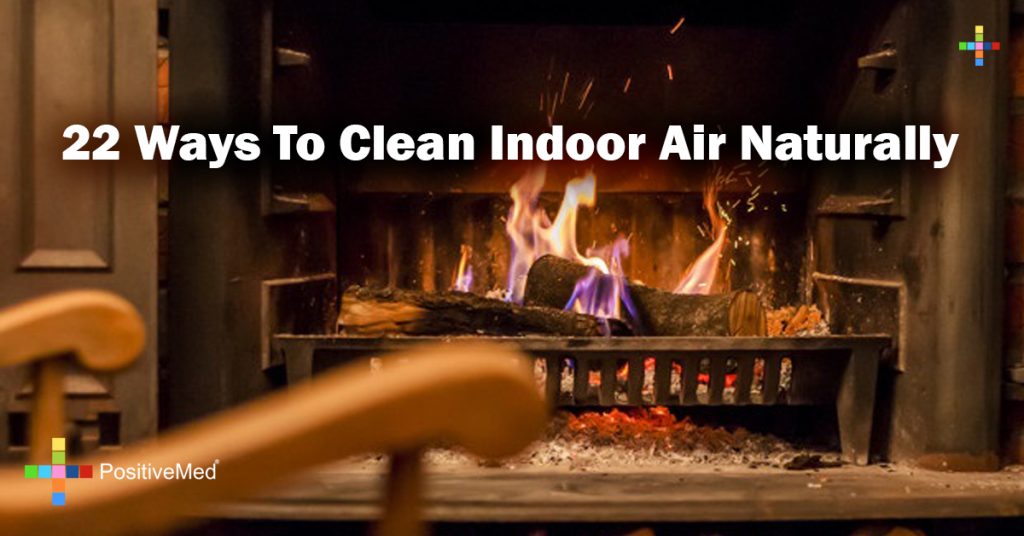
22 Ways To Clean Indoor Air Naturally
By Khrystyana Kirton
Edited by Stephanie Dawson
Reviewed by Nima Shei MD
According to the The American Lung Association the indoor air quality of one’s home could be 2-5 times worse than the air outdoors, thanks to a study done by the EPA! That is pretty scary considering some reports say we spend 90% of our time indoors. So, there are a few strategies that the EPA recommends for reducing indoor air pollution, controlling sources of pollution, ventilating adequately and cleaning indoor air.

-
Proper Filters: Did you know that the air filter in your heating and cooling system can help create healthier indoor air by capturing airborne allergens such as pollen, mold spores, dust mite debris, smoke, pet dander, and smog from the air passing through the filter? Sort of like vacuuming your air! (and you don’t have to put much effort into the work it is doing! Bonus!)
-
New filters: Change out your air filters regularly, the filter mentioned above lasts up to 3 months, but if you are a big remodeler like me consider changing it out a little more often during times of construction!
-
Other filters: Don’t forget your other filters! There are filters and screens around your home, for example: air purifiers, dryer lint screens, vacuum cleaners, range hood screens, and bathroom exhaust fan grilles, for starters. Be sure to keep them clean or replace them as needed.
-
Please Remove Your Shoes. Believe it or not your shoes are covered with a fine layer of chemicals, dirt, bacteria, and mold. These contaminates will settle onto your flooring, carpeting, and rugs. Then as you walk around you can stir up these particles, causing you and your family to breathe them in.
-
Fresh air. Opening a window isn’t always the best choice. Be sure to check the air quality and pollen levels outside before opening the windows.
-
Cooking: When you are using your stove top, be sure to turn on your outdoor venting fan to help moist, smoky, or chemical laden air to leave the house.
-
Dry Cleaning: Try to get your dry cleaning done with a few days to spare for them to air out at the dry cleaners! That way you can pick them up after they have dried completely and have let off most chemicals. There are also less toxic dry cleaning options, so be sure to do your research.
-
Attached Garage: Be sure to open the garage door fully before starting a car. When pulling back into the garage be sure to leave the door open for a few minutes after turning the car off to allow fumes to escape. Otherwise, over time the carbon monoxide can enter the home.
-
Fireplaces: Be sure the fireplace flue is inspected by a pro to be sure that it is working properly and keep those particles out of indoor air.
-
Bathroom Fans: When showering or using hot water in a bathroom, be sure to use bathroom fans to vent out all the steam and extra moisture in the bathroom air that can cause mold and mildew growth.
-
No Air Fresheners! Homeowners often turn to products to help mask odors in the home but often times do not realize that they may also contribute to poor indoor air quality. According to the EPA air fresheners actually release VOC’s into the air. Scented candles and incense may contain particulates, soot and chemicals. For a safer air freshener, dip cotton balls in a sweet smelling extract or essential oil and stash them around the house.
-
Vacuum Often. Ideally, we should be vacuuming twice a week. It’s a great way to get rid of excess dust, dust mites, lead, mold, and pet dander. Use a vacuum cleaner that has a HEPA type filter, so while cleaning it’s not spitting the dust back into the air. Consider changing bags and or cleaning filters outside.
-
Beware of Cleaners. Household cleaners, even “green” cleaners often contain cancer-causing chemicals. The best bet is to use truly non-toxic cleaners like baking soda, salt, lemon juice, essential oils, and vinegar.
-
Say NO to Dusting! Dry dusting, that is. Don’t just dust or mop with dry cloths, instead use a damp cloth. This avoids spreading and lifting dust into the air.
-
Launder! Don’t forget to launder window coverings regularly. When it comes to draperies, dust can settle often. Either launder them according to the manufacturer directions, or vacuum them with the proper attachment.
-
Clean Sheets! Wash bedding bi-monthly, if not weekly. (130 degrees F to kill dust mites)
-
Mattresses: Vacuum mattresses, couches, and chairs quarterly.
-
VOC Free Paints- More and more paint lines have options for VOC low or free paints. (volatile organic compounds = bad) Wherever possible opt for these types of paint, the fewer fumy chemicals in the home, the better. Especially as off-gassing can continue for a long time.
-
Control Dust Mites: Whenever possible, opt for hard surface flooring. Be sure to vacuum and or launder throw rugs often!
-
Pet Dander: This is a tough one, but try to prevent animal dander from accumulating. Most doctors suggest that people allergic to animal dander not keep household pets with feathers or fur. Ban them from any bedrooms and be sure to keep the doors closed.
-
Lethal Fumes: Beware of lethal fumes and be sure to have adequate alarms for these types of gases: carbon monoxide, radon, and second-hand smoke. Make sure to install a carbon monoxide detector and have a radon test performed in the home, and please do not smoke indoors nor allow friends to.
-
Plants: There are several great plants that can help your air to be cleaned of toxins. One caveat to adding plants is that you have to be sure to control the water and not create a mold or mildew problem! Also if you have children or pets, be sure to know what plants are poisonous before bringing them into your home. Great air filtering plants include:


-
Orchids: may seem like a hard to plant to care for, but they actually thrive on neglect. Don’t kill them with kindness (too much water and sunlight). They filter: xylene , a pollutant found in many glues and paints. Orchids respire and give off oxygen at night – so they’re great for the bedroom! And they just look so good in decor which is win/win!
-
Palms: hardy, exotic-looking, and easy to grow, palms filter formaldehyde, benzene and carbon monoxide
-
Philodendrons need very little attention. They filter xylene, a toxin found in glues and leathers.
-
Aloe Vera – Aloe is mostly know for medical uses like relieving burns, but it’s also easy to keep alive, and sculptural-looking. Also, aloe filters formaldehyde!






